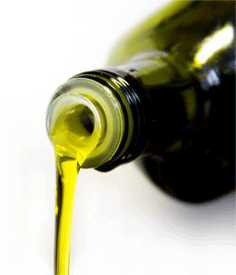By day, Maris Callahan is a publicist in New York City. In her spare time, she is a freelance writer and food blogger at In Good Taste, a blog about cooking and eating good healthy food when you’re busy or on-the-go (with a few indulgences, because everyone needs those!) When she isn’t cooking or writing she enjoys running, knitting, photography and a good latte. 
Anyone who has been on a diet has probably heard the golden rule of weight reduction: burn more calories than you eat. Though there are a variety of diets that suit different lifestyles, taste buds and appetites, many health professionals would agree that a low-calorie diet combined with exercise is a reliable way to shed pounds.
So then why do they tell us to eat olive oil? By reading the nutrition label, one might think that olive oil should be considered an occasional indulgence and used sparingly. The good news is that dieters don’t need to pass on the heart-healthy antioxidant source in order to maintain or lose weight.
With approximately 120 calories per and 14 grams of fat per tablespoon, olive oil provides numerous health benefits. The classic pantry staple is said to help prevent cancer and certain types of heart disease. To get the most “bang” for your caloric buck, choose “extra virgin” or “virgin” oil, which have the highest levels of antioxidants. While all types of olive oil provide monounsaturated fat (which is also known as “good fat” and linked with health benefits), it’s important to know that not all olive oil is created equal.
Extra Virgin is the highest quality olive oil is a result of the first pressing of whole olives done within a day of harvest. With the sharpest taste and a light color and flavor, this is perfect for dressing salads or marinates for poultry, meat or vegetables. Light olive oil refers to the oil’s color and taste, and pure olive oil is often common for cooking and baking. From a cook’s perspective, olive oil may not be the best choice for cooking at a high temperature. The sediment naturally found in extra virgin olive oil can make it more likely to burn or smoke. Canola and peanut oils have a higher smoke point.
Want to enjoy olive oil and still stick to your diet? Try these simple vegetable recipes from DietsInReview.com, or from some popular food blogs:
From Kalyn’s Kitchen: Baked Swiss Chard Stems with Olive Oil
From Simply Recipes: Roasted Cauliflower
From Pinch My Salt: Sweet & Sour Grilled Pumpkin
Guest Blog Series: Look for the following badge on your favorite health sites to see if they have been a featured guest blogger on DietsInReview.com. See other posts in the Guest Blog series.
If you would like to apply to be featured as a guest blogger, please contact us.

